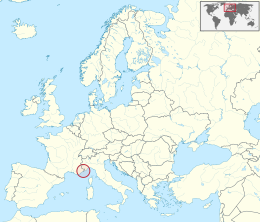Commons:Copyright rules by territory/Monaco
|
Copyright rules: Monaco Shortcut: COM:MONACO | |
 | |
 | |
| Durations | |
|---|---|
| Standard | Life + 50 years |
| Anonymous | Publisher life + 50 years |
| Posthumous | Publish + 50 years |
| Government | Public domain |
| Other | |
| Freedom of panorama | No |
| Terms run to year end | Yes |
| ISO 3166-1 alpha-3 | MCO |
| Treaties | |
| Berne convention | 30 May 1889 |
| URAA restoration date* | 1 January 1996 |
| *A work is usually protected in the US if it is a type of work copyrightable in the US, published after 31 December 1928 and protected in the country of origin on the URAA date. | |
This page provides an overview of copyright rules of Monaco that are relevant to uploading works into Wikimedia Commons. Note that any work originating in Monaco must be in the public domain, or available under a free license, in both Monaco and the United States before it can be uploaded to Wikimedia Commons. If there is any doubt about the copyright status of a work from Monaco, refer to Law 491 for clarification.
Governing laws
Monaco has been a member of the Berne Convention since 30 May 1889.[1]
As of 2018 the World Intellectual Property Organization (WIPO), an agency of the United Nations, listed Loi n. 491 du 24/11/1948 sur la protection des œuvres littéraires et artistiques as the main copyright law enacted by the legislature of the Monaco.[1]
The law came into effect on 1 January 1949.[491/1948 Art.35] It applies to all literary or artistic works that were not in the public domain when it came into force.[491/1948 Art.36] WIPO holds Law No. 491 as amended up to Law No. 1.313 of June 29, 2006 in their WIPO Lex database.[2]
Applicability
The law applies to works authored or co-authored by a citizen of Monaco, and to all works first published in Monaco.[491/1948 Art.34] Other works are protected as defined by international conventions. Applied art works are protected in Monaco to the same extent that they are protected in their country of origin.[491/1948 Art.34] Authors have rights in all literary and artistic works that they create with no requirement for any formality.[491/1948 Art.1] The rights of the author may be transferred in whole or part by gift, sale or inheritance, with some limitations on inheritance.[491/1948 Art.14]
Works protected by copyright include all literary, scientific and artistic productions, whatever their mode or form of expression, such as books, pamphlets and other writings; lectures, addresses, sermons and similar works; dramatic or dramatico-musical works; choreographic works and pantomimes whose staging is fixed in writing or otherwise; musical compositions with or without words; cinematographic works and those obtained by a process analogous to cinematography; works of drawing, painting, architecture, sculpture, engraving, lithography; photographic works and those obtained by a process analogous to photography; works of applied arts; illustrations, maps, plans, sketches and plastic works relating to geography, topography, architecture or science.[491/1948 Art.2]
Durations
Under Loi n. 491 du 24/11/1948,
- The author has the sole right to publish, reproduce or otherwise disclose their work, and has the exclusive right to authorise any translation, arrangement or adaptation of their work.[491/1948 Art.3-4]
- The author of a translation, arrangement or adaptation has rights to their work without prejudice to the rights of the author of the original work.[491/1948 Art.5]
- For individual works, copyright lasts 50 years after the author's death.[491/1948 Art.12]
- For posthumous works, copyright lasts 50 years after publication.[491/1948 Art.12]
- A collaborative work is the common property of the authors, but when it is not an indivisible whole each of the co-authors has the right to exploit their personal contribution separately.[491/1948 Art.7] For collaborative works, copyright lasts 50 years after the death of the last surviving author.[491/1948 Art.12]
- The publisher of an anonymous or pseudonymous work is treated as the author. However, if the identity of the author is established, the author or their successors obtain the copyright.[491/1948 Art.13]
In the above definitions, "50 years after [event]" means "up to the end of the 50th year after the year in which [event] happened."
Not protected
See also: Commons:Unprotected works
Laws, ordinances, orders, decisions and administrative, judicial or official publications do not benefit from copyright protection.[491/1948 Art.38]
Freedom of panorama
See also: Commons:Freedom of panorama
Not OK: Chapitre - III RESTRICTIONS À L'EXERCICE DES DROITS (Chapter - III RESTRICTIONS ON THE EXERCISE OF RIGHTS) does not contain an exception that allows photographic and/or videographic reproductions and commercial publication and/or distribution of images of copyright-protected architecture and artistic works situated in public places.
Il est permis de publier des emprunts faits à des œuvres littéraires ou artistiques, à condition d'en indiquer la source et l'auteur lorsque ces publications ont un caractère scientifique, scolaire ou constituent des chrestomathies.
— in: 491/1948 Art.16
It shall be permissible to publish borrowings made from literary or artistic works, provided that the source and author are indicated where the publications are of a scientific, scholarly or chrestomathic nature.
— Translation of Article 16
See also
Citations
- ↑ a b Monaco : Copyright and Related Rights (Neighboring Rights). WIPO Lex (2018). Retrieved on 2018-10-28.
- ↑ Loi n. 491 du 24/11/1948 sur la protection des œuvres littéraires et artistiques (in French). Monaco (2006). Retrieved on 2018-10-28.